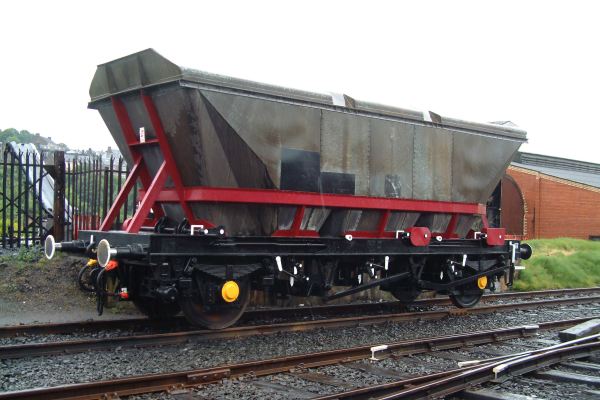


This is the prototype MGR wagon type HOP 32AB, in which description "HOP" refers to the hopper design, "32" indicates the capacity in tons (achieved by utilising the volume of the top canopy) and "AB" refers to the air brake. The later TOPS designation of this variant of the MGR wagon is HCA - signifying that the wagon has a canopy and can run at 45mph loaded and 60mph empty in block formation.
The Merry-Go-Round system was introduced in 1964, as an innovative way of supplying coal from collieries to power stations using permanently coupled sets of high capacity, air braked wagons, automatically loaded and unloaded in a non-stop operation. Locomotives are provided with slow speed control, so that as trains pass through the handling plant they can be automatically loaded, discharged and weighed. Whereas previously wagons had to be individually shunted for unloading by tippling, in principle, merry-go-round trains require no shunting at collieries or power station.
The Merry-Go-Round system represented a considerable investment by British Railways and by the National Coal Board. However, it was estimated that each MGR wagon replaced about 14 older wagons. Fewer locomotives, sidings, train crews, shunters and wagon examiners were needed, and train speeds were faster, so making more effective use of the working railway.
Over 10,000 of these wagons were built, and they became the most common wagon type in service in Britain. A steel underframe and support frame support the galvanised hopper body. The hopper is steeply sloped to assist the rapid discharge of coal through three sets of bottom double doors (though discharge of wet coal can be difficult in freezing conditions). The air brake operates on discs on two wheels at opposite corners of the wagon. Single link suspension, Timken roller bearings and Oleo hydraulic buffers complete the modern specification.
Wagons built without a top canopy had a capacity of 26 tons. Those provided with a top canopy (or "top skip") could carry 32 tons, to which the wagon weight of 13 tons adds to 45 tons gross weight, which was the maximum load that could be carried on two axles when these wagons were designed.
Canopied wagons found extensive use in Scotland, where collieries such as Seafield at Kirkcaldy were equipped with modern loading facilities which could accommodate the extra height. Wagons delivering coal to Cockenzie Power Station, where no continuous loop line is provided, require to be shunted. However Longannet Power Station achieves optimum working by use of a loop line facility, and two trains can be unloaded simultaneously, subject to the capacity of the receiving bunker.
This wagon was generously donated to SRPS by EWS. It was overhauled, cleaned up and repainted at EWS Worksop MGR Depot before being delivered to Bo'ness on 30th June 2008.
More details from HAA - The Wagon That Powered The Nation...
